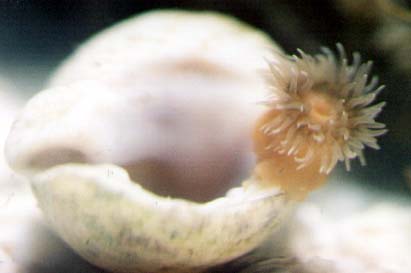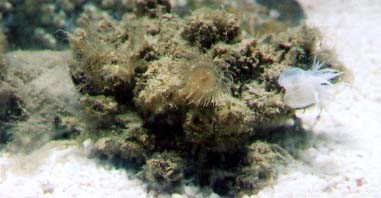
 |
The sea was flat as a pancake, and bright blue as the sky was clear and sun breached the fluffy clouds. The spring tide at Worthing recedes to its maximum around dawn and dusk. A 5.8 metre* (measured at Shoreham Harbour) falling to 0.0 metres low was just sufficient to uncover the rock and sand terrain beneath the amusement pier. At first glance, the shore appears exclusively sandy and in all respects one of the least promising of rockpooling shores. Firm sand leads the explorer out to below mid-tide region where the sand gives away to a mixed ground with rocks buried in the sand, a few looser rocks (cobble-sized), and shallow sandy pools. There are straggly strands of the green seaweed Enteromorpha on this shore, and a few red seaweeds try to gain a holdfast, but are generally sparse and unsuccessful colonisers.
(* Readings for Shoreham Harbour entrance)
Hermit
Crabs off Worthing
Photograph
by Paul Parsons
Mussel Community
Under the steel girders of the pier is the best area, with the supports providing attachment points of a sizeable mussel community. Mussels are a rich source of food for many animals, and the community including barnacles, provides incidental nutrition and shelter for other communities. However, because of building work on the pier supports, most of the mussels have been scraped off during 1999. There are still thousands with accompanying Dogwhelks. Grey Topshells are common on this shore.
| Common Name | Scientific Name | Frequency | Comments |
| Beadlet Anemone | Actinia equina | Common
(100+) |
No large specimens were seen. |
| Snakelocks Anemone | Anemonia viridis | Common | A lot of sand had been deposited and a lot of the sea anemones, included the Snakelocks were covered up. I have seen more on this shore, but were probably more common than Beadlets. |
| Star Ascidian | Botryllus schlosseri | Occasional
colonies (c. 9) |
Including one on the whelk shell of a Hermit Crab |
| Edible Crab | Cancer pagurus | Frequent
(25+) |
Undersized, c. 50 mm broad crabs buried in sand under rocks. |
| Shore Crab | Carcinus maenas | Common
(100+) |
More large ones than usual (20+) but only the small ones made the numbers up. |
| Squat Lobster | Galathea squamifera | Common
(200+) |
Only very small ones, many missing a claw, under rocks. |
| Rock
Goby
(juveniles) |
Gobius paganellus | Abundant
(1000+) |
In shallow pools and under rocks |
| Blenny
(juveniles) |
Lipophrys pholis | Common
(250+) |
In shallow pools and under rocks |
| Long-legged
Spider Crab |
Macropodia rostrata | Frequent | Although only tiny one was discovered, these crabs are good at disguising themselves and others must have been overlooked. |
| Plumose Anemone | Metridium senile | Frequent
(25+) |
A very small number of small white specimens for this area. |
| Worm Pipefish | Nerophis lumbriciformis | One | Under an Enteromorpha covered rock 15 metres to the east of the pier. Came as a complete surprise as I have never seen this fish on Sussex shores before, although there is a record in the MERMAID database. |
| Hermit Crab | Pagurus bernhardus | Abundant
(1000+) |
Only one seen in a Whelk shell, all the others were small inhabiting Grey Topshell, Dogwhelk, Periwinkle, Netted Dogwhelk, and a few other shells. |
| Prawn | Palaemon elegans | Common
(100+) |
No really large pools. Palaemon serratus was probably also present, but all the prawns were small. |
| Hairy Crab | Pilumnus hirtellus | Frequent
(25+) |
Many less than normally discovered on this shore. |
| Long-clawed
Porcelain Crab |
Pisidia longicornis | Very
Common
(500+) |
Underside of rocks and boulders |
| Common Goby | Pomatoschistus microps | Abundant
(1000+) |
At first, I thought some could be another goby species. Most were juveniles |
| Broad-clawed
Porcelain Crab |
Porcellana platycheles | Common
(100+) |
Underside of rocks and boulders |
| Sea Anemone | Sagartia troglodytes | Common
(250 +) |
Deposited sand obscured this species. There could have been thousands, but they were buried. |
26 October 2000
A juvenile Tompot Blenny, Parablennius
gattorugine, collected from the shore at Worthing
is unusual, although I have seen one before this late in the year when
the shore fauna is scanty. AH.
10 March 2001
Very poor shore fauna in the fading light, after
about 6 months of rain most days. Anemones are scarce with just a few Plumose
Anemones, an occasional Snakelocks Anemone, and no Sagartia troglodytes
to be seen easily. Unusually for this shore, Beadlet Anemones were the
commonest. Adult Blennies were discovered at the low tide mark. Some of
these had been fighting and showed the head injuries of the male fish after
they get into fights.
The
Ringed
Plover reveals itself by its swift running
over the shingle. Without moving it is too well camouflaged and difficult
to spot. The summer residents birds and much plumper than the lean winter
visitors. As the tide ebbs and the water recedes, more (a half dozen in
50 metres of sand) of these small birds appear on the emerging sand flats.
 Under
the sea, Paul Parsons returned from a brief foray with a handful of very
small Actinothoe
sea anemones, a small (sacoglassan sea slug) sea hare Elysia
viridis, and some other very small
orange anemones with whitish orange tentacles. After close study I think
these are the often overlooked Diadumene
cincta. The mouth is orange in some specimens, but the most
useful diagnostic difference from the similar Plumose
Anemones is their instant jerky reaction when touched.
Under
the sea, Paul Parsons returned from a brief foray with a handful of very
small Actinothoe
sea anemones, a small (sacoglassan sea slug) sea hare Elysia
viridis, and some other very small
orange anemones with whitish orange tentacles. After close study I think
these are the often overlooked Diadumene
cincta. The mouth is orange in some specimens, but the most
useful diagnostic difference from the similar Plumose
Anemones is their instant jerky reaction when touched.

Sea
Anemones (Link)
17 September 2001
I
recorded my first specimen of the Hairy Hermit Crab, Pagurus
cuanensis, intertidally at Worthing Pier.
It looked very strange at first, like a small Long-legged Spider Crab, Macropodia rostrata, living in a Dogwhelk, Nucella, shell.
The low spring tides at Worthing was nothing special. The Maja Spider Crab had a missing leg. Bait colllectors test if they are soft or not by pulling off their legs, although with this one it may have had an accident.
The juvenile Herring Gulls, Larus argentatus, paddled in the pools, their legs trying to induce worms to the surface. The adults were a bit lazier, possibly hunting for the Squat Lobsters, Galathea squamifera, which were common, small ones, under rocks.
16 October 2001
The tide went out a long way past the foot of the pier, but the light faded fast and it was hard to see anything. Fish were represented by young BullheadsTaurulus bubalis, 5-Bearded Rockling adults Ciliata mustela, a few first year juvenile Common Blennies Lipophrys pholis, and a few Sand Gobies Pomatoschistus minutus, and a solitary young Tompot Blenny, Parablennius gattorugine.
Crustaceans included a few small Hermit Crabs Pagurus bernhardus, in Grey Topshells, Squat Lobsters, Galathea squamifera, Shore Crabs Carcinus maenas (20+) in larger numbers than in the summer as well as Edible Crabs Cancer pagurus (20+) were hiding under rocks and boulders, partially buried in the sand and gravel.
There
were no sea anemones noticeably in the murky
light, no draping Plumose from the pier supports, or Sagartia troglodytes
between the stones (most of the sand had been scoured away) and no Snakelocks
Anemones seen in the pools. Beadlet Anemones
were common under boulders.
Wildlife News: Marine Latest
|
|
|
|
|
News 2018 |
Membership Form |
|